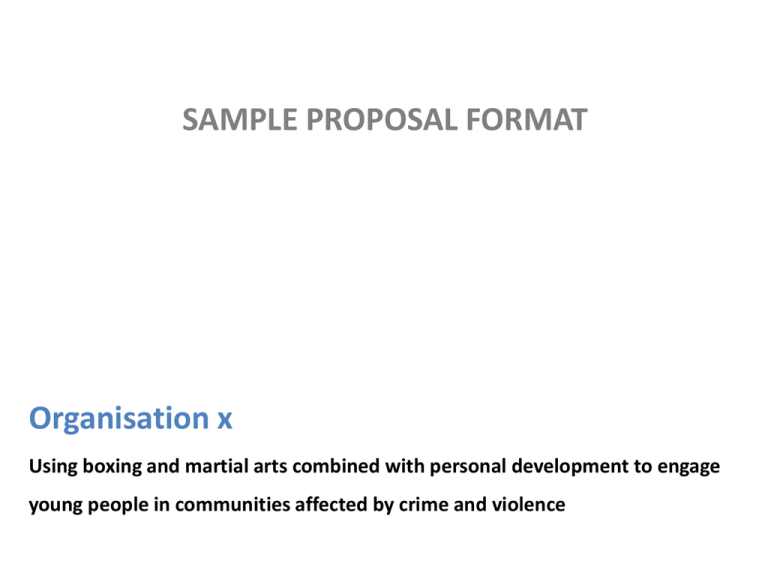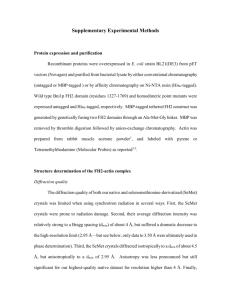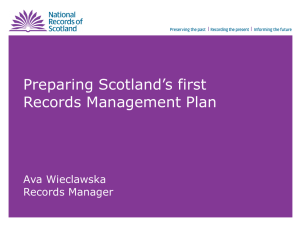Power Point Doc - Fight For Peace
advertisement

SAMPLE PROPOSAL FORMAT Organisation x Using boxing and martial arts combined with personal development to engage young people in communities affected by crime and violence Executive Summary This first page should summarise the whole proposal so that the reader has an idea of what to expect. This helps ensure they read the detailed sections of the document with an awareness of what you’re proposing to deliver, and what you need from them. At FFP we normally use the following structure, with no more than one or two sentences for each paragraph: • What your organisation does – such as your mission statement. For FFP it would be “we use Boxing and Martial Arts combined with education and personal development to realise the potential of young people in communities that suffer from crime and violence”. • A description of the proposed activity – what are you asking for support to do? • What will the impact of the work be: the issues it will address, the communities it will focus on, and the number of young people it will support, and the differences it will make. • Mention the fact that you are working with FFP on this programme. This means you are using a methodology that has been proven in the extreme context of Rio, and you will be supported to develop your approach. • What you are asking for from the reader of this document. This could be a list of specific items or equipment, it could be a general request of financial or partnership support, it could be a specific amount of money The issues this programme will target This slide provides the opportunity for you to explain the issues you’re targeting, and to demonstrate that you have a good level of understanding and knowledge before starting your work. By explaining them at different levels you can also demonstrate that you’re aware of how your work fits into a broader context, which is where many funders will focus. The programme will focus on the following issues: Explain the issues that you will target from a statistical level – perhaps how they affect your country and / or city. This is important to demonstrates that you know about the issues that you are working on. Fight for Peace would probably point to the following statistics in this section, focusing on Brazil and Rio, or UK and London, as appropriate: • Homicide rates • Gang and crime involvement statistics • Youth Unemployment rates • School attendance etc. The specific communities that we will be working in include: Describe the specific communities in which you will work, how those issues described above affect or manifest in those communities, and any particular dynamics that illustrates why you are targeting your intervention there. The group of young people that you will target: Describe the young people that your programme will target. How are they involved in or affected by those issues above? What defines them as a target group? What are the risks and influences around them? Introducing x organisation Provide a summary of your organisation . You can include: • Mission • History • Basic organisational structure • The services you offer • The size and scale of operations • Any notable achievements Make sure the information you give here is compelling, concise, and relevant to the issues you’ve set out on the previous slide. The temptation here is to give too much detail in a way that is unstructured and unstrategic, or to use a generic description of your organisation that you use for many different purposes. Be very deliberate about what you share - give them information that is tailored to this proposal and that makes you sound credible, qualified to tackle the issues you’ve described, and capable of delivering the programme you’re proposing. They should read this page and feel excited about working with you, and confident in your ability on this specific challenge. The solution: (programme name) Describe the activities that you’re proposing. Be clear and practical. Explain what will actually happen during the activities, and what young people will experience. Don’t give more background or context, get into the specific details of delivery. They should leave this slide with absolute clarity has to how your programme will work. You can do this in different ways, but one format that might help is: Summary Give a summary of the programme, where it will take place, how many young people it will target, and what it aims to achieve. For FFP we might say: we plan to set up a gym where we’ll offer B&MA combined with education, to 35 young people in Mare, and work with them to help them to leave gangs. Methodology Describe the services you’re going offer, and the theory behind why your programme works. For FFP we would describe the 5 pillars as the services we offer, and describe our theory as our use of B&MA to attract hard to reach young people, and when they’re in the gym helping them to access the other pillars. Approach Provide the real detail of how the methodology will be applied in a series of bullet points. Include things like: • How many classes a week, over what period of time • Who the coaches and staff will be • How you’ll attract the young people • If you’re using a curriculum where it’s been developed and how it will be used • Any partners you might work with to deliver additional services Why Boxing and Martial Arts? Some funders or partners might need persuading of the positive attributes of B&MA. If this is the case you can use the ‘Why B&MA’ arguments and theory that we shared with you in Rio, and that have been established by FFP through 12 years of delivery experience in Rio and London. B&MA is a key for connecting with young people from communities affected by violence. ADRENALINE & STATUS – In communities affected by violence, young people often seek adrenaline and excitement, or want to learn to fight and defend themselves. Combat sports attract young people because of the language of strength and challenge, and opportunities for status and admiration. • BELONGING & IDENTITY – Belonging to a group, and having people that are ‘on your side’, is important to young people. Being part of a B&MA club provides young people with a sense of belonging and identity. • HEALTHY BODY & HEALTHY MIND – Young people tell us that they feel better after practicing these sports. B&MA provide a tangible focus for energy, frustration, stress, and emotions, as well as a natural endorphin release all of which leave young people feeling calmer. B&MA sports are rich sources of transferrable life skills • DISCIPLINE & RESPECT – Many young people haven’t experienced positive examples of boundary-setting or reasoned interactions. Through the traditions and ideas that are taught in B&MA, young people learn about rules, boundaries, discipline, exchange and respect. • SELF-RELIANCE & SELF-CONTROL – Ultimately, these are individual as opposed to collective pursuits. B&MA training teaches self-reliance, facing fears, self-motivation, stamina, setting goals and targets, concentration, self-control and discipline. B&MA competition provides additional, intensified experiences of standing on your own, facing a crowd, the link between preparation and performance, taking responsibility for winning and losing, and dealing with disappointment. B&MA provide organisations with a platform for broader and deeper work with young people • LESSONS IN THE RING / LESSONS IN LIFE – When delivered within a holistic, values-based programme that includes sessions that focus on personal development, young people are able to apply what they learn in the sports to their daily lives. • 1-TO-1 MENTORING SUPPORT – B&MA training requires a strong one-to-one relationship between the coach and the young person. B&MA provides the opportunity for young people to experience a constructive, positive relationship with an adult, who can identify and respond to their wider needs. • PEACE THROUGH INNER STRENGTH & CONFIDENCE – Young people become more open to alternative resolutions of conflict or difficult situations, because they no longer feel they need to prove themselves physically. B&MA build confidence and inner strength and enable young people to feel strong and respected, while still being a peaceful person. Development Plan This is an important part of the pitch as it allows you the opportunity to highlight to potential supporters of the progress you have already made and that you have a clear vision for where the project will go. This will lend credibility to your pitch and show organisation and a clear plan are central to you operations. A tip is to include stages of the plan that have already been delivered so that it shows you’re already underway and the programme has momentum. A development plan could be: Project Planning: Detail the initial stages of your planning process Methodology Development: This could include your training in Rio and the initial stages of support Stakeholder Engagement: Any engagement to date, and your plans for future engagement with stakeholders and potential partners/funders Project Preparation: What you need to put in place to launch a pilot phase, i.e. recruitment of coaches, outreach work, purchasing equipment… Pilot Phase: Outline the size and scope of your pilot phase Pilot Evaluation: How and what you would evaluate and what you would hope to learn Full delivery: What you would deliver if you achieved the required support Impact Evaluation: Your ideas for expected outcomes, what you intend to monitor and your plan for impact evaluation Impact, and monitoring and evaluation It’s crucial to show prospective partners and funders that right from the start of your programme design you are focused on the impact your programme will create, and that you understand in detail exactly what the impact will be. It’s also important to set out how you plan to monitor and evaluate that impact, again right from the start of your programme, so that you know whether it’s delivering the intended changes for young people. Programme outputs Describe here elements of your programme that you can easily count – number of young people involved, number of activities delivered, number of staff recruited, number of sessions attended etc. Programme outcomes Describe the changes or results you expect your programme will deliver as a result of the outputs above (what you did). NB these should be closely linked to the issues you talked about in the Issues section. For FFP, the expected outcomes might include: As a result of taking part in FFP, young people will: • feel more confident about themselves • be better able to take up opportunities and make proactive decisions about their future, • be more resilient towards challenges, • hold improved relationships, • have better physical fitness, • be less likely to get involved in gang or violent behaviour, • increase their attendance, discipline and achievement at school, gain better qualifications, • have better access to work. Monitoring and evaluation strategy Your partnership with FFP can help here. Bec will design with you an approach to collecting information that tells you how effective the programme is, as it’s happening (monitoring data), and helps you to evaluate the success of the programme at it’s conclusion. In this section you should describe the approach, and the fact that you have the support of FFP in designing and implementing that approach. Building on a proven model and supported by Fight for Peace We think that being supported by FFP, and using the proven FFP methodology will add strength to your proposal. Our association also means that you can talk about results that we’ve achieved, and highlight the fact that you’re using the same methodology, and so can expect similar results. We’re prepared the following text that you can use to talk about your partnership: Organisation x was selected to be a member of the Fight for Peace Global Alumni. FFP selects organisations to be FFP Alumni members if they assess them as having high-levels of access and credibility in their communities, and the capability to successfully adapt and deliver the FFP approach to maximise impact for the young people they work with. Being an Alumni member means x programme will be based on a proven methodology, and that x organisation will receive substantial training and support from FFP during the development of the programme. FFP uses boxing and martial arts combined with personal development and education to help realise the potential of young people affected by crime and violence. FFP was founded in 2000 in the Complexo da Maré favela in Rio de Janeiro as a response to young people being employed in drug trafficking gangs. Over the last 12 years FFP has a developed a comprehensive methodology which uses boxing and martials arts, alongside education, work access, youth support services and youth leadership. To date FFP has worked with over 6000 young people, including those who are deeply entrenched in gang structures, and those who are at risk of future involvement. The FFP methodology has been externally evaluated by the University of East London (2012) and proven to deliver social impact. As an FFP Alumni member, organisation x will be supported to deliver comparable results with young people in country x. Young people engaged with FFP: • Resist becoming involved in crime, and desist from criminality and drug trafficking; between 60% and 70% say they are less inclined to commit crimes, carry weapons and join a gang; about 75% say they have stopped getting into trouble at school, and 82% in Rio, and 93% in London say they have stopped getting into trouble on the streets. • Overcome divisions and creative positive relationships in local communities; this is most apparent in Rio where there are divisions across drug factions and 59% say they feel safer in other communities and there is evidence that divisive community values are being challenged by young people’s actions. • Learn and practice conflict resolution and peace making skills; over 80% in Rio felt more able to cooperate with others, accept those who are different and have more respect for others, and 71% said that their relationships with their family has improved. In London 46% say they have improved family relationships and 59% better relationships with adults. • Attend education courses, and achieve qualifications and work; a pass rate of over 70% for young people who are mostly NEETs (not in education, employment or training), and without formal education qualifications; 73% NEETs progressed to education, training and employment in London and 64% of education students progressed in Rio. In Rio 41% found work and 46% in London were employed six months after the end of their courses. • Improve their fitness and lead a healthier lifestyle; so that they can improve their boxing and martial arts skills, and get fitter; 96% in London, 82% in Rio say they are fitter, and most feel better about their health. • Train harder and to a high standard; we have young people who compete locally, nationally and even internationally, this inspires FFP members, and enhances the reputation of FFP. The FFP model in the UK has also been found to deliver Government savings on crime-spend of £4.42 per £1 invested (Ecorys Research, 2012) ***NEED TO PROVIDE REFERENCES FOR THE REST OF THE STATS*** Support already received Here you should outline your existing funders and partners. This lends credibility to your pitch as it shows prospective organisations that others have confidence in your programme and may well highlight areas for multi-lateral funding and partnerships. You can include organisations that you have secured relationships, but also organisations that you’re still in discussions with to show that you’re well networked and engaging a number of organisations to work with you. Partners: The following partners are already in place. We are working with them to do… We are in advanced discussions with the following partners. They will help us to do… (Partners could share resources with you, help recruit young people into your programme, co-deliver the programme etc.) Funders The following funders are already in place. They are supporting us to do… We are in advanced discussions with the following partners. They will help us to do… (Funders can include financial donors and in-kind supporters providing things like facilities, volunteers, equipment etc.) The support we are requesting for x organisation Make specific requests of the funder, and therefore each time you use this document edit this page to fit the audience. Research the potential funder to establish what areas they fund, who they’ve worked with in the past, what their objectives are as an organisation, and if they favour any particular types of organisation or relationship when making a grant . You can structure this slide with the following headings: We need X from you It will support Y element of the programme The social impact of this investment will be Remember that you might want to ask for items other than money, such as : in-Kind Support, equipment, or partnership working (i.e. access to the young people they already work with). You can also ‘bundle’ requests together, i.e. funding and volunteering skills, and this is a very effective way to build a deeper relationship. Businesses are especially keen on these types of relationships because they provide an opportunity for their staff to get involved in their charitable giving. It also shows that you’re aware of where you need capacity support and that you’re keen to develop as an organisation. To find out more about our organisation please visit our website: www…. To find out more about our project please contact person x: Email Phone To find our more about the FFP Global Alumni Programme visit www.fightforpeace.net Alternatively please contact james.baderman@fightforpeace.net











